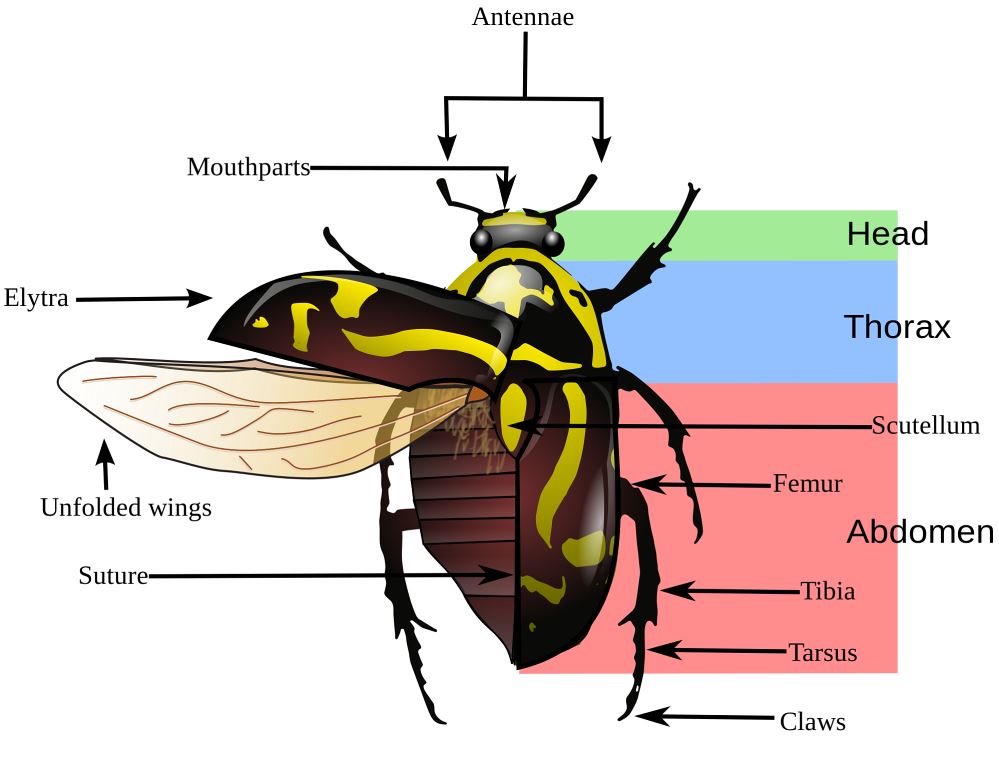One of the most important features of Coleoptera is their ‘elytra’, the hard exoskeletal which covers their wings. The ‘elytra’ helps to protect the beetle but also has many other functions, too. Some beetles trap moisture in their wings and the elytra protects it from drying in heat and wind, this means the beetles can travel across arid deserts without dehydrating. Other Coleoptera can live under water because they can store air in their wings, which is again protected by the elytra. Coleoptera (beetles) are most probably the most versatile creatures on earth. The beetles exoskeleton is made up of numerous plates called sclerites (a hardened body part), separated by thin sutures. This design creates the armoured defenses of the beetle while maintaining flexibility check.

Scientists interested in cuticle structure[1] have examined cuticle from the elytra of the red flour beetle, Tribolium castaneum. The elytra have two proteins in large amounts that are not present in the membranous hindwings. These proteins are associated with hard cuticle both in the elytra and elsewhere on the beetle. The cuticle of the elytra becomes hard and rigid from extensive crosslinking, or chemical connections between the protein strands. This evidence from red flour beetle suggests that in the evolutionary past, an ancestor of modern beetles had a mutation caused proteins for cuticle crosslinking to be expressed in the forewings. The up regulation of two cuticle genes in the forewings may be a key to the evolution of elytra with https://yesgirls.net/tag/えろたれす/.
The elytra are not used for flight, but tend to cover the hind part of the body and protect the second pair of wings. The elytra must be raised in order to move the hind flight wings. A beetles flight wings are crossed with veins and are folded after landing, often along these veins, and are stored below the elytra.

In some beetles, the ability to fly has been lost. These include the ground beetles (family Carabidae) and some ‘true weevils’ (family Curculionidae), but also some desert and cave-dwelling species of other families. Many of these species have the two elytra fused together, forming a solid shield over the abdomen. In a few beetle families, both the ability to fly and the elytra have been lost, with the best known example being the glow-worms of the family Phengodidae, in which the females are larviform (where the females in the adult stage of metamorphosis resemble the larvae to various degrees) throughout their lives.
“Nature is replete with examples of layered-structure materials that are evolved through billions of years to provide high performance. Insect elytra (a portion of the exoskeleton) have evoked worldwide research attention and are believed to serve as fuselages and wings of natural aircraft. This work focuses on the relationship between structure, mechanical behavior, and failure mechanisms of the elytra. We report a failure-mode-optimization (FMO) mechanism that can explain elytra’s mechanical behaviors. We show initial evidence that this mechanism makes bio-structures of low-strength materials strong and ductile that can effectively resist shear forces and crack growth. A bio-inspired design of a joint by using the FMO mechanism has been proved by experiments to have a potential to increase the interface shear strength as high as about 2.5 times. The FMO mechanism, which is based on the new concept of property-structure synergetic coupling proposed in this work, offer some thoughts to deal with the notoriously difficult problem of interface strength and to reduce catastrophic failure events.” [2]
REFERENCES:
[1] Mi Young Noh, Karl J. Kramer, Subbaratnam Muthukrishnan, Michael R. Kanost, Richard W. Beeman, Yasuyuki Arakane. Two major cuticular proteins are required for assembly of horizontal laminae and vertical pore canals in rigid cuticle of Tribolium castaneum. Insect Biochemistry and Molecular Biology. 53: 22-29.
[2] Fan, J.; Chen, B.; Gao, Z.; Xiang, C. 2005. Mechanisms in Failure Prevention of Bio-Materials and Bio-Structures. Mechanics of Advanced Materials and Structures. 12(3): 229-237.
[3] Species 2000 & ITIS Catalogue of Life
![]()
